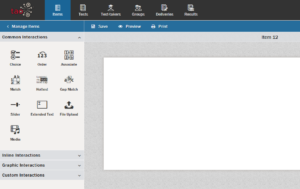Overview: Adding interactions
“Interactions allow the candidate to interact with the item. Through an interaction, the candidate selects or constructs a response.”
-Question and Test Interoperability standard, published by IMS Global.
Interactions are inserted into an item during the item authoring process. They are the building blocks for Items (which in turn are the building blocks for Tests), and serve as the basic unit for Test-taker responses. The term Interaction should not be considered interchangeable with the term Item: other than conceptually, interactions cannot exist outside of an item, thus there are no concrete instances of interactions outside of items. One way to conceptualize the difference is to compare a TAO assessment to an examination delivered on paper, and think of the interaction as the pen the test-taker is holding, and the item(s) as the exam paper itself.
There are four categories of interaction: Common Interactions, Inline Interactions, Graphic Interactions and Custom Interactions (also known as PCI interactions). Currently, 19 of these interactions are recognized by the QTI standard. 17 of these are available in TAO. In the library on the left of your newly created item, you will see the Common Interactions catalog, and the other types of interaction are below this. You can navigate these catalogs to choose the types of interaction you want to use for your item. The following gives you a brief description of each category:
- Common Interactions (QTI) cover many of the simple interactions that are often used in assessment
- Inline Interactions (QTI) are interactions which contain text-based elements
- Graphic Interactions (QTI) are interactions which contain graphic elements
- Portable Custom Interactions (PCI) are developed for a specific scenario, mostly to fulfill a specific need of a customer
The image below shows the Interactions library: the Common Interactions catalog is open, and the other catalogs are below it.

The two sub-sections of the Guide QTI Interaction Types and PCI Interaction Types contain chapters on each type of interaction available in TAO. Each of these chapters gives you information on how to use that interaction in your item.
Note that an item generally contains only one interaction type, but you can create an item which contains more than one interaction: Item complexity ranges from simple items with a single interaction to composite items with multiple interactions. Once you have added and prepared one interaction in your item, drag another interaction template from the Interactions Library onto the Canvas below or beside the interaction you have just authored, and repeat the authoring process for the new interaction.
In TAO, interactions include the mechanisms used to score the interaction itself. For simple Items, correct answers add to the Test score, unlike incorrect answers. Scoring a composite item using standard response templates (match correct, map response, or map response point) are often a more complicated sum. See the section on Scoring for more information on scoring.
With the exception of project-specific PCIs, each of the interactions is described in detail in its own chapter, either under QTI Interaction Types or PCI Interaction Types.
Note: Identifiers which can be configured in Interactions need to contain only ASCII characters due to QTI restrictions. ASCII character replacements are described on sites such as Oracle and ASCII Code.
